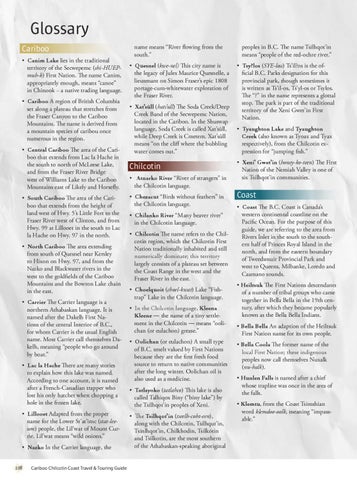Glossary Cariboo • Canim Lake lies in the traditional territory of the Secwepemc (shi-HUEPmuh-k) First Nation. The name Canim, appropriately enough, means “canoe” in Chinook – a native trading language. • Cariboo A region of British Columbia set along a plateau that stretches from the Fraser Canyon to the Cariboo Mountains. The name is derived from a mountain species of caribou once numerous in the region. • Central Cariboo The area of the Cariboo that extends from Lac la Hache in the south to north of McLeese Lake, and from the Fraser River Bridge west of Williams Lake to the Cariboo Mountains east of Likely and Horsefly. • South Cariboo The area of the Cariboo that extends from the height of land west of Hwy. 5’s Little Fort to the Fraser River west of Clinton, and from Hwy. 99 at Lillooet in the south to Lac la Hache on Hwy. 97 in the north. • North Cariboo The area extending from south of Quesnel near Kersley to Hixon on Hwy. 97, and from the Nazko and Blackwater rivers in the west to the goldfields of the Cariboo Mountains and the Bowron Lake chain in the east. • Carrier The Carrier language is a northern Athabaskan language. It is named after the Dakelh First Nations of the central Interior of B.C., for whom Carrier is the usual English name. Most Carrier call themselves Dakelh, meaning “people who go around by boat.” • Lac la Hache There are many stories to explain how this lake was named. According to one account, it is named after a French-Canadian trapper who lost his only hatchet when chopping a hole in the frozen lake. • Lillooet Adapted from the proper name for the Lower St’at’imc (stat-leeum) people, the Lil’wat of Mount Currie. Lil’wat means “wild onions.” • Nazko In the Carrier language, the 108
Cariboo Chilcotin Coast Travel & Touring Guide
name means “River flowing from the south.”
peoples in B.C. The name Tsilhqot’in means “people of the red-ochre river.”
• Quesnel (kwe-nel) This city name is the legacy of Jules Maurice Quesnelle, a lieutenant on Simon Fraser’s epic 1808 portage-cum-whitewater exploration of the Fraser River.
• Tsy?los (SYE-loss) Ts’il?os is the official B.C. Parks designation for this provincial park, though sometimes it is written as Ts’il-os, Ts’yl-os or Tsylos. The “?” in the name represents a glottal stop. The park is part of the traditional territory of the Xeni Gwet’in First Nation.
• Xat’sūll (hats’ull) The Soda Creek/Deep Creek Band of the Secwepemc Nation, located in the Cariboo. In the Shuswap language, Soda Creek is called Xat’sūll, while Deep Creek is Cmetem. Xat’sūll means “on the cliff where the bubbling water comes out.”
Chilcotin • Atnarko River “River of strangers” in the Chilcotin language. • Chezacut “Birds without feathers” in the Chilcotin language. • Chilanko River “Many beaver river” in the Chilcotin language. • Chilcotin The name refers to the Chilcotin region, which the Chilcotin First Nation traditionally inhabited and still numerically dominate; this territory largely consists of a plateau set between the Coast Range in the west and the Fraser River in the east. • Choelquoit (choel-kwat) Lake “Fishtrap” Lake in the Chilcotin language. • In the Chilcotin language, Kleena Kleene — the name of a tiny settlement in the Chilcotin — means “oolichan (or eulachon) grease.” • Oolichan (or eulachon) A small type of B.C. smelt valued by First Nations because they are the first fresh food source to return to native communities after the long winter. Oolichan oil is also used as a medicine. • Tatlayoko (tatlahco) This lake is also called Talhiqox Biny (“biny lake”) by the Tsilhqot’in peoples of Xeni. • The Tsilhqot’in (tseelh-coht-een), along with the Chilcotin, Tsilhqut’in, Tsinlhqot’in, Chilkhodin, Tsilkótin and Tsilkotin, are the most southern of the Athabaskan-speaking aboriginal
• Tyaughton Lake and Tyaughton Creek (also known as Tyoax and Tyax respectively), from the Chilcotin expression for “jumping fish.” • Xeni’ Gwet’in (honey-ko-teen) The First Nation of the Nemiah Valley is one of six Tsilhqot’in communities.
Coast • Coast The B.C. Coast is Canada’s western continental coastline on the Pacific Ocean. For the purpose of this guide, we are referring to the area from Rivers Inlet in the south to the southern half of Princes Royal Island in the north, and from the eastern boundary of Tweedsmuir Provincial Park and west to Queens, Milbanke, Loredo and Caamano sounds. • Heiltsuk The First Nations descendants of a number of tribal groups who came together in Bella Bella in the 19th century, after which they became popularly known as the Bella Bella Indians. • Bella Bella An adaption of the Heiltsuk First Nation name for its own people. • Bella Coola The former name of the local First Nation; these indigenous peoples now call themselves Nuxalk (nu-halk). • Hunlen Falls is named after a chief whose trapline was once in the area of the falls. • Klemtu, from the Coast Tsimshian word klemdoo-oolk, meaning “impassable.”
